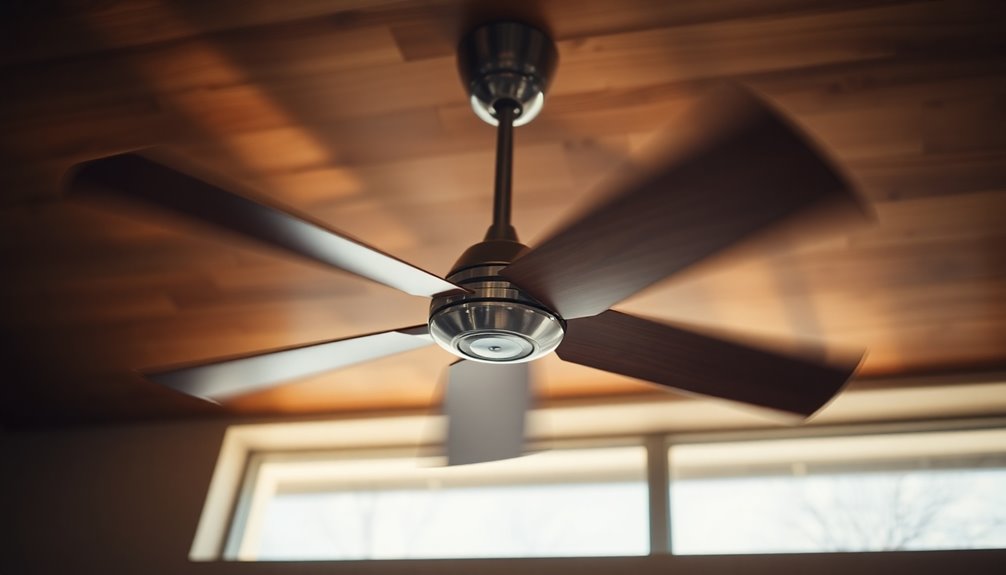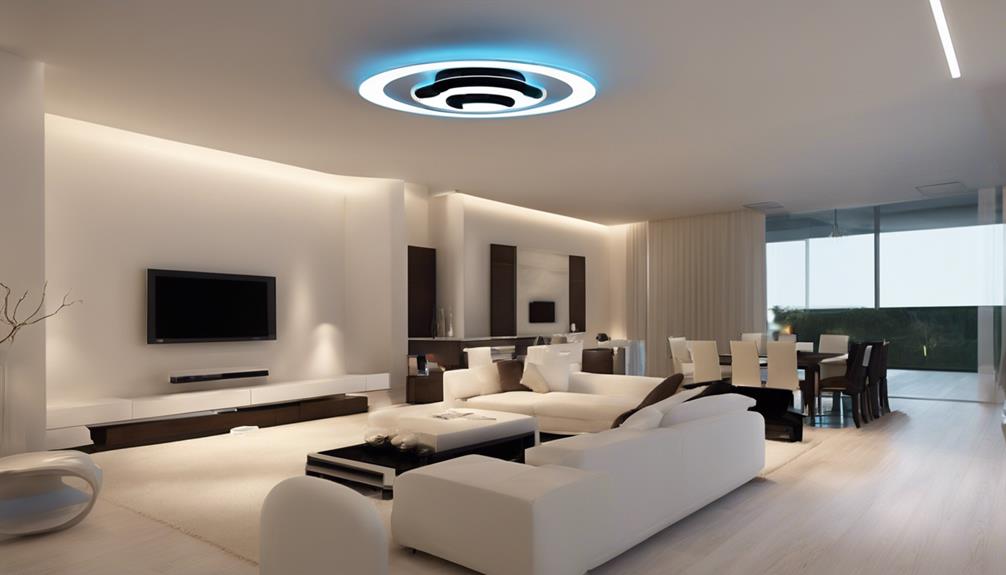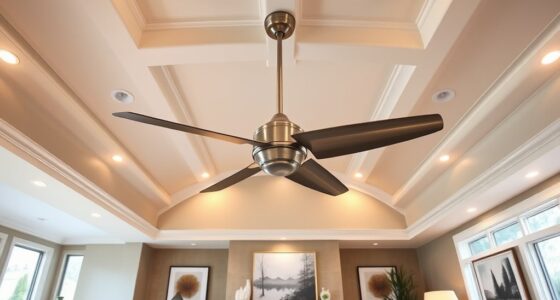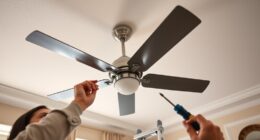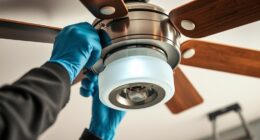A ceiling fan typically uses between 50 to 100 watts, depending on its size and efficiency. For example, a standard 48-inch fan averages around 75 watts while smaller models may use closer to 100 watts. Energy-efficient fans, especially those with BLDC technology, can operate on just 28 watts. If you run your fan for about 12 hours a day, expect it to consume approximately 0.9 kWh daily. Choosing the right fan can markedly impact your energy bills. Stick around to find out how to select the most efficient option for your needs.
Key Takeaways
- Typical ceiling fan wattage ranges from 50 to 100 watts, with average models consuming around 75 watts.
- Energy-efficient fans using BLDC technology can operate on as little as 28 watts.
- Daily energy consumption can vary; a 75-watt fan running 12 hours uses about 0.9 kWh.
- Monthly costs for running a ceiling fan depend on usage; 12 hours daily can cost approximately ₹135.
- Choosing energy-efficient models can significantly reduce electricity costs and overall power consumption.
Understanding Ceiling Fan Wattage

When you're considering a ceiling fan for your space, understanding its wattage is essential for managing energy consumption. Ceiling fan wattage typically falls between 50 to 100 watts, with the average wattage for a 48-inch fan being around 75 watts.
If you opt for a smaller fan, like a 30-inch model, expect it to consume close to 100 watts. Larger fans might use even more power due to their higher air delivery rates.
It's important to note that energy-efficient models, particularly those using BLDC technology, can operate on as little as 28 watts, drastically cutting down your overall power consumption. Traditional fans usually range between 50 to 75 watts, so if you're looking to save on electricity, you may want to explore energy-efficient options.
To determine a fan's wattage accurately, refer to user manuals and device labels, as they provide the necessary information for your energy consumption calculations.
Calculating Power Consumption

Calculating the power consumption of a ceiling fan is straightforward and essential for managing your energy bills. To find the power in watts, you can use the formula: Power (watts) = Voltage (volts) x Current (amperes).
In India, with a typical household voltage of 230 volts, if your ceiling fan operates at 0.3 amperes, its power consumption would be 69 watts (230V x 0.3A).
To estimate daily energy consumption, simply multiply the wattage of your ceiling fan by the number of hours it runs. For instance, a 75-watt fan running for 8 hours consumes 600 watt-hours or 0.6 kWh.
This information helps you understand how much energy your fan uses daily.
To calculate the monthly cost of running your ceiling fan, take the daily kWh consumption and multiply it by the cost per unit of electricity. If the rate is ₹5 per unit, then 0.6 kWh x ₹5/unit equals ₹3 per day.
Knowing the wattage and consumption allows you to choose energy-efficient ceiling fans and keep your electricity costs in check.
Daily and Monthly Usage
Understanding how much you use your ceiling fan each day and month can help you manage your energy costs effectively. A typical ceiling fan consumes around 75 watts. If you run it for 12 hours daily, your power consumption totals about 900 watt-hours or 0.9 kWh per day.
This translates to a monthly usage of approximately 27 kWh, which can lead to an electricity cost of around ₹135 if your electricity rate is ₹5 per unit.
If you decide to use your ceiling fan for just 8 hours daily, it'll consume 600 watt-hours, equating to 0.6 kWh. This daily usage would cost you roughly ₹3.
However, keep in mind that costs can vary considerably based on your usage habits. For instance, if you're running a ceiling fan continuously for 24 hours, your monthly electricity cost could soar to about ₹270.
To maximize energy efficiency and minimize your electricity costs, consider adjusting your daily usage. By being mindful of how long you run your ceiling fan, you can effectively manage your monthly expenses while staying cool.
Comparing Different Ceiling Fans

Ceiling fans come in various models and efficiencies, which can greatly impact your energy consumption and costs. When comparing ceiling fans, you'll notice that traditional ceiling fans typically consume between 50 to 100 watts, depending on their size and motor type.
For example, an average 48-inch ceiling fan usually uses around 75 watts, while a smaller 36-inch fan may consume about 55 watts.
In contrast, energy-efficient models, especially Energy Star-certified ceiling fans, can use as little as 28 watts, making them a better choice for reducing your electricity bill. Additionally, ceiling fans with BLDC motors, like Atomberg's Gorilla series, operate at approximately 35 watts, further minimizing power consumption.
It's essential to take into account both the wattage and air delivery efficiency when selecting a fan. Higher air delivery efficiency means you get more airflow for less electricity, leading to a lower cost of running the fan over time.
Energy Efficiency Solutions

When it comes to energy efficiency solutions for cooling your home, choosing the right ceiling fan can make a significant difference.
Energy-efficient ceiling fans, especially those featuring BLDC technology, can consume as little as 28 watts. This is a stark contrast to traditional fans that often use 75 watts or more, helping you save on electricity bills. By installing Energy Star-rated ceiling fans, you could achieve energy savings of up to 50%, making them a smart cooling solution.
To maximize efficiency, consider using ceiling fans in conjunction with your air conditioning. This allows you to raise your thermostat setting by several degrees, cutting air conditioning energy usage by up to 30%.
Regular maintenance is essential; keep fan blades clean and verify proper installation to boost efficiency and extend the fan's lifespan.
Additionally, employing smart controls or timers can optimize your fan's usage, guaranteeing it operates only when necessary. This approach is key to reducing power consumption and enhancing your home's overall energy efficiency.
Frequently Asked Questions
How Much Does It Cost to Run a Ceiling Fan 24 Hours a Day?
Running a ceiling fan for 24 hours a day can cost you anywhere from ₹4.2 to ₹12, depending on the fan's wattage.
If you use a typical 75-watt fan, expect to pay around ₹9 daily.
However, energy-efficient models consume less power, making them more economical.
Do Ceiling Fans Use a Lot of Electricity?
Oh, sure, ceiling fans are just voracious monsters consuming electricity like it's their last meal!
But in reality, they're more like the friendly neighborhood energy savers. You'll find that they use around 50 to 100 watts, with energy-efficient models sipping just 28 watts.
Is It OK to Run a Ceiling Fan 24 7?
Yes, it's generally fine to run a ceiling fan 24/7.
Doing so can help keep your space comfortable without relying heavily on air conditioning, which uses more energy.
Just remember, fans cool people, not rooms, so turn it off when you leave an area to save energy.
Regular maintenance is also essential for efficiency, especially if you opt for energy-efficient models that consume less power while providing the same cooling effect.
How Much Electricity Does a Ceiling Fan Use in 24 Hours?
If you're curious about how much electricity a ceiling fan uses in 24 hours, it typically consumes between 75 to 100 watts per hour.
This means that if you run a 75-watt fan all day, it'll use about 1.8 kilowatt-hours.
At an average rate of ₹5 per unit, you're looking at a cost of roughly ₹9 for a full day's operation.
Conclusion
To sum up, knowing how much power a ceiling fan uses can help you make smarter choices for your home. Did you know that a typical ceiling fan uses between 50 to 100 watts? By selecting energy-efficient models, you can save up to 40% on your electricity bill compared to older fans. So, when you're looking to beat the heat, consider not just comfort but also your energy consumption—your wallet will thank you!

